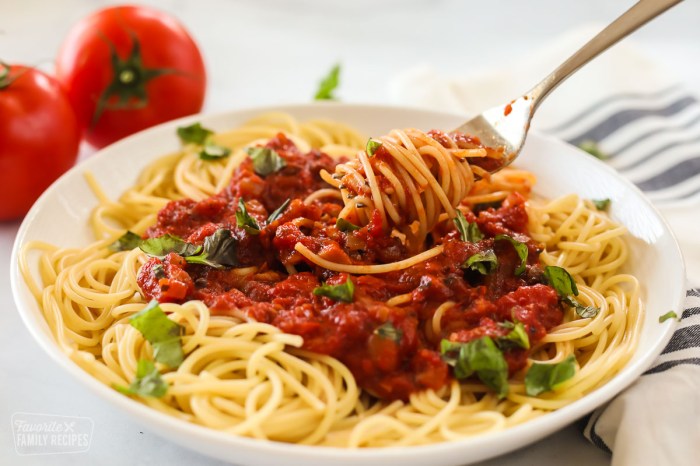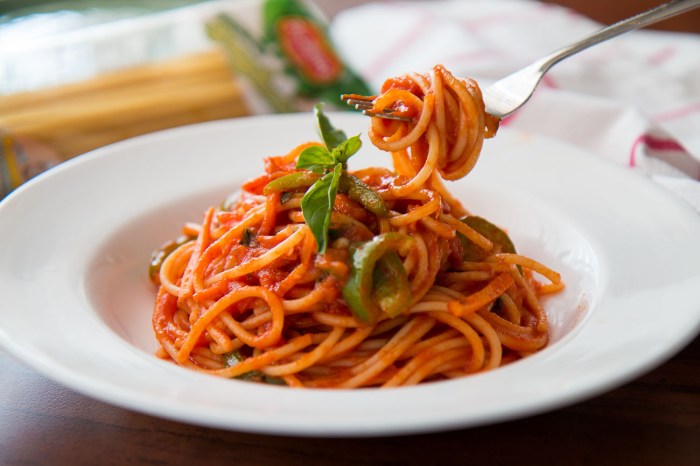
Easy Spaghetti with Tomato Sauce: A Comforting Classic
Easy spaghetti with tomato sauce is a dish that transcends cultures and generations, a simple yet satisfying meal that holds a special place in our hearts. From the humble origins of Italian cuisine to its global popularity, spaghetti with tomato sauce has become a symbol of comfort, tradition, and culinary versatility.
It’s a dish that can be enjoyed by everyone, from seasoned chefs to novice cooks, and its adaptability allows for endless variations and personal touches.
This blog post will delve into the world of easy spaghetti with tomato sauce, exploring its history, variations, and the simple joy it brings to our tables. We’ll uncover the secrets behind a perfect tomato sauce, discuss different toppings and flavor profiles, and discover the cultural significance of this beloved dish.
Join me on a culinary journey as we celebrate the magic of easy spaghetti with tomato sauce.
Ingredients and Preparation

This classic dish is a staple in many households and is a perfect example of a simple yet delicious meal that can be prepared in under 30 minutes. It’s also a great way to use up leftover ingredients and experiment with different flavors.
Ingredients and Substitutions
This section provides a list of essential ingredients, along with possible substitutions and their nutritional value. This information allows for flexibility in the recipe and caters to different dietary needs and preferences.
| Ingredient | Substitution | Nutritional Value | Notes |
|---|---|---|---|
| Spaghetti | Linguine, fettuccine, or other long pasta | Carbohydrates, protein, fiber | Choose whole-wheat pasta for added fiber and nutrients. |
| Tomato sauce | Crushed tomatoes, tomato paste, or homemade sauce | Lycopene, vitamins A and C, potassium | Use a high-quality sauce with minimal added sugar and preservatives. |
| Olive oil | Avocado oil, coconut oil, or butter | Healthy fats, vitamin E | Choose a high-quality olive oil for optimal flavor and health benefits. |
| Garlic | Shallots, onions, or a pinch of garlic powder | Antioxidants, vitamins B6 and C | Fresh garlic adds a pungent and savory flavor to the sauce. |
| Salt and pepper | Herbs and spices like oregano, basil, thyme, or chili flakes | Flavor enhancers | Season to taste, and experiment with different herbs and spices for variety. |
Preparing the Sauce
This section explains the steps involved in preparing the tomato sauce, providing a detailed guide to achieve a flavorful and aromatic sauce.
- Heat the olive oil in a large saucepan over medium heat.
- Add the minced garlic and cook for about 1 minute, or until fragrant.
- Pour in the tomato sauce and bring to a simmer.
- Reduce heat to low and simmer for 15-20 minutes, stirring occasionally, to allow the flavors to meld.
- Season with salt and pepper to taste.
- Add any additional herbs or spices desired.
Cooking the Pasta
This section Artikels the steps for cooking the pasta, ensuring it is cooked al dente, meaning it has a slight firmness when bitten.
Sometimes, you just crave the simplicity of a classic easy spaghetti with tomato sauce. But if you’re looking for a bit more adventure, a quick and flavorful asian beef and vegetable stir fry is a great alternative. Both dishes are easy to make and offer a satisfying meal, but the stir fry brings a burst of vibrant flavors and textures that can be just what you need to shake things up.
After all, variety is the spice of life, and sometimes, even the simplest spaghetti needs a little competition.
- Fill a large pot with water and bring to a boil.
- Add salt to the boiling water. This seasons the pasta and prevents it from sticking together.
- Add the spaghetti to the boiling water and cook according to the package directions, typically 8-10 minutes.
- Drain the pasta in a colander.
- Toss the cooked pasta with the tomato sauce.
- Serve immediately and enjoy!
Variations and Enhancements: Easy Spaghetti With Tomato Sauce
Beyond the classic tomato sauce, there are endless possibilities to elevate your spaghetti experience. Different variations of tomato sauce offer unique flavor profiles, while a plethora of toppings can add texture, color, and an explosion of taste.
Tomato Sauce Variations, Easy spaghetti with tomato sauce
The foundation of spaghetti with tomato sauce is, of course, the sauce itself. While the basic recipe is simple, there are many variations that add depth and complexity to the dish. These variations often differ in the ingredients used, the cooking time, and the overall flavor profile.
- Marinara: This classic Italian sauce is made with tomatoes, garlic, onion, and herbs like oregano and basil. It’s typically cooked for a long time to allow the flavors to meld and develop a rich, deep taste. Marinara is known for its bright acidity and fresh, herbaceous notes.
- Arrabbiata: As the name suggests, arrabiata means “angry” in Italian, and this sauce lives up to its name with its spicy kick. Arrabbiata is made with tomatoes, garlic, and chili peppers, often with a touch of red pepper flakes for extra heat.
Sometimes, the simplest dishes are the most satisfying. Easy spaghetti with tomato sauce is a classic for a reason – it’s comforting, familiar, and always hits the spot. But if you’re looking for a sweet treat to round out your meal, I highly recommend trying a strawberry rhubarb custard pie.
It’s the perfect combination of tart and sweet, and the creamy custard adds a touch of decadence. After all, a good meal deserves a delicious ending, and this pie will definitely leave you wanting more.
It’s a bold and flavorful sauce that’s perfect for those who enjoy a bit of spice.
- Puttanesca: This sauce is a flavorful combination of tomatoes, olives, capers, garlic, anchovies, and chili flakes. The salty, briny flavors of the olives and capers, combined with the umami richness of the anchovies, create a complex and savory sauce that’s both delicious and satisfying.
Toppings for Spaghetti with Tomato Sauce
Once you’ve chosen your tomato sauce, the next step is to consider toppings. These additions can elevate the dish from simple to spectacular, adding a variety of textures, flavors, and colors.
- Cheese: Parmesan cheese is a classic topping for spaghetti with tomato sauce, adding a salty and nutty flavor. Other options include ricotta cheese, mozzarella cheese, and even a sprinkle of pecorino romano for a sharper, more intense flavor.
- Herbs: Fresh herbs like basil, parsley, oregano, and thyme can add a burst of freshness and aroma to the dish. You can add them directly to the sauce, sprinkle them on top, or even use them to create a pesto to drizzle over the pasta.
Sometimes, after a simple weeknight meal like easy spaghetti with tomato sauce, I crave something sweet and comforting. That’s when I turn to my go-to recipe for no knead cinnamon and raisin bread. It’s incredibly easy to make, and the warm, cinnamon-raisin aroma fills the house, making the spaghetti taste even better! And the best part?
It’s perfect for enjoying with a scoop of vanilla ice cream for a satisfying dessert.
- Vegetables: Roasted vegetables like eggplant, zucchini, and bell peppers can add sweetness and texture to the dish. You can also add fresh vegetables like spinach, mushrooms, or cherry tomatoes for a more vibrant and colorful presentation.
Flavor Profile Combinations
The beauty of spaghetti with tomato sauce lies in its versatility. You can create endless variations by combining different tomato sauces, toppings, and flavor profiles. Here’s a table that highlights some popular combinations:
| Flavor Profile | Tomato Sauce | Toppings | Additional Notes |
|---|---|---|---|
| Classic Italian | Marinara | Parmesan cheese, fresh basil | A timeless combination that highlights the simplicity and freshness of Italian cuisine. |
| Spicy and Savory | Arrabbiata | Crushed red pepper flakes, grated pecorino romano, chopped fresh parsley | Perfect for those who enjoy a bit of heat. The pecorino romano adds a sharp, salty flavor that complements the spicy sauce. |
| Mediterranean Delight | Puttanesca | Black olives, capers, fresh oregano, a drizzle of olive oil | The briny flavors of the olives and capers, combined with the umami richness of the anchovies, create a complex and savory sauce that’s both delicious and satisfying. |
| Vegetarian Delight | Marinara | Roasted eggplant, zucchini, and bell peppers, fresh mozzarella cheese, a sprinkle of oregano | A hearty and flavorful dish that’s perfect for vegetarians. The roasted vegetables add sweetness and texture, while the mozzarella cheese provides a creamy richness. |
Serving and Presentation

A simple dish like spaghetti with tomato sauce can be elevated with creative plating and thoughtful accompaniments. By presenting it in a visually appealing way, you can transform a basic meal into a satisfying and memorable dining experience.
Plating Styles and Garnishes
The way you plate your spaghetti with tomato sauce can significantly impact its visual appeal. Here are some plating styles and garnishes to consider:
- Classic Approach:A simple and elegant way to serve spaghetti is to mound it in the center of a plate, creating a small “nest” with the pasta. You can then top it with a generous spoonful of tomato sauce and garnish with fresh basil leaves, grated Parmesan cheese, or a sprinkle of red pepper flakes.
- Spiral Presentation:For a more modern and artistic look, try twisting the spaghetti into a spiral shape on the plate. This creates a visually interesting centerpiece that can be further enhanced with a drizzle of olive oil, a sprinkle of herbs, or a dollop of ricotta cheese.
- Rustic Style:To achieve a rustic and homey feel, serve the spaghetti in a shallow bowl with a generous portion of tomato sauce. You can then add a few pieces of crusty bread alongside the pasta, creating a comforting and satisfying presentation.
Accompanying Dishes
Complementing your spaghetti with tomato sauce with other dishes can create a well-rounded meal. Consider these options:
- Salads:A fresh salad with a light vinaigrette dressing provides a refreshing contrast to the richness of the pasta. A simple caprese salad with mozzarella, tomatoes, and basil, or a green salad with mixed greens, cucumbers, and red onion, would pair well with the spaghetti.
- Bread:A crusty bread, such as sourdough or ciabatta, can be used to soak up any leftover sauce. You can also serve garlic bread or focaccia for a more flavorful accompaniment.
- Desserts:A light and refreshing dessert, such as a fruit salad or sorbet, can provide a satisfying end to the meal. You can also serve a classic Italian dessert like tiramisu or panna cotta.
Creating a Visually Appealing Presentation
To make your spaghetti with tomato sauce visually appealing, focus on the following:
- Color Contrast:Use ingredients that create a pleasing color contrast. For example, the bright red of the tomato sauce can be balanced by the green of basil, the white of mozzarella, or the yellow of grated Parmesan cheese.
- Texture Variety:Combine different textures to create a more interesting presentation. The soft pasta can be contrasted with the crispness of a salad, the crunch of bread, or the creamy texture of cheese.
- Plate Choice:The plate you choose can also impact the visual appeal of your dish. A white plate will highlight the colors of the food, while a rustic-style plate will create a more casual and homey feel.
Cultural and Historical Context
The history of spaghetti with tomato sauce is a fascinating journey that intertwines culinary innovation, cultural exchange, and global influence. It’s a dish that has evolved over centuries, reflecting the changing tastes and traditions of different societies.
The Origins of Spaghetti with Tomato Sauce
The origins of spaghetti with tomato sauce can be traced back to the 16th century, when tomatoes were first introduced to Europe from the Americas. The tomato was initially met with skepticism, as it was believed to be poisonous. However, it gradually gained acceptance as a culinary ingredient, and by the 18th century, it was being used in various dishes, including sauces.
- The use of tomatoes in sauces was particularly popular in Naples, Italy, where the dish “spaghetti al pomodoro” originated.
- The early versions of spaghetti with tomato sauce were simple, using only tomatoes, olive oil, garlic, and basil.
- As the dish evolved, other ingredients were added, such as onions, oregano, and chili peppers.
The Role of Spaghetti with Tomato Sauce in Italian Cuisine
Spaghetti with tomato sauce is considered a staple dish in Italian cuisine, and it is enjoyed by people of all ages and social classes. The dish is versatile and can be adapted to suit different tastes and preferences.
- It is often served as a simple and satisfying meal, but it can also be dressed up with additional ingredients, such as seafood, meat, or vegetables.
- The dish is also a popular choice for celebrations and special occasions.
- The popularity of spaghetti with tomato sauce in Italy is a testament to the enduring appeal of simple, flavorful, and satisfying food.
The Global Influence of Spaghetti with Tomato Sauce
Spaghetti with tomato sauce has become one of the most popular dishes in the world, enjoyed in countries on every continent. Its global influence can be attributed to several factors, including:
- The simplicity and affordability of the dish.
- The delicious and satisfying flavor profile.
- The widespread availability of ingredients.
Cultural Significance of Spaghetti with Tomato Sauce
The cultural significance of spaghetti with tomato sauce varies across different countries. In some cultures, it is viewed as a classic Italian dish that evokes a sense of tradition and nostalgia. In other cultures, it is seen as a casual and affordable meal that is enjoyed by people from all walks of life.
- In the United States, spaghetti with tomato sauce is often associated with childhood memories and family gatherings.
- In China, spaghetti with tomato sauce is a popular dish that has been adapted to local tastes and preferences.
- In India, spaghetti with tomato sauce is often served with a side of rice or bread.






